Rectification of Bowl-Shape Deformation of Tidal Flat DEM derived from UAV Imaging
Abstract
:1. Introduction
2. Proposed Approach of LHD Matching
3. Experiment and Results
- Case 1: 7 parameters ()
- Case 2: 10 parameters (, ,)
- Case 3: 13 parameters (, ,,)
- Case 4: 13 parameters (, ,)
- Case 5: 16 parameters (, ,,)
- Case 6: 19 parameters (, ,,,)
- Case 7: 22 parameters (,,,,, )
- Case 8: 16 parameters (, ,,)
- Case 9: 19 parameters (, , ,,)
- Case 10: 22 parameters (,,,,,)
- Case 11: 25 parameters (,, ,,, ,)
4. Conclusions
Author Contributions
Funding
Conflicts of Interest
References
- Marani, M.; D’Alpaos, A.; Lanzoni, S.; Carniello, L.; Rinaldo, A. Biologically-controlled multiple equilibria of tidal landforms and the fate of the Venice lagoon. Geophys. Res. Lett. 2017, 34, 1–5. [Google Scholar] [CrossRef]
- Kim, K.L.; Kim, B.J.; Lee, Y.K.; Ryu, J.H. Generation of a large-scale surface sediment classification map using unmanned aerial vehicle (UAV) data: A case study at the Hwang-do tidal flat, Korea. Remote Sens. 2019, 11, 229. [Google Scholar] [CrossRef] [Green Version]
- Baker, C.; Lawrence, R.L.; Montagne, C.; Patten, D. Change detection of wetland Ecosystems using Landsat imagery and change vector analysis. Wetlands 2007, 27, 610–619. [Google Scholar] [CrossRef]
- Koh, C.H.; Khim, J.S. The Korean tidal flat of the Yellow Sea: Physical setting, ecosystem and management. Ocean Coast. Manag. 2014, 102, 398–414. [Google Scholar] [CrossRef]
- Won, J.S.; Na, Y.H.; Kim, S.W. Tidal flat DEM generation by satellite remote sensing. In Proceedings of the 2003 International Geoscience and Remote Sensing Symposium, Toulouse, France, 21–25 July 2003. [Google Scholar]
- Ryu, J.H.; Kim, C.H.; Lee, Y.K.; Won, J.S.; Chun, S.S.; Lee, S. Detecting the intertidal morphologic change using satellite data. Estuar. Coast Shelf Sci. 2008, 78, 623–632. [Google Scholar] [CrossRef]
- Jaud, M.; Grasso, F.; Dantec, N.L.; Verney, R.; Delacourt, C.; Ammann, J.; Deloffre, J.; Grandjean, P. Potential of UAVs for monitoring Mudflat Morphodynamics (Application to the Seine Estuary, France). ISPRS Int. J. Geo Inf. 2016, 5, 50. [Google Scholar] [CrossRef] [Green Version]
- Wimmer, C.; Siegmund, R.; Schwäbisch, M.; Moreira, J. Generation of high precision DEMs of the Wadden Sea with airborne interferometric SAR. IEEE Geosci. Remote Sens. 2000, 38, 2234–2245. [Google Scholar] [CrossRef]
- Ross, P.H.; Ustin, S.L.; Hastings, A. Use of lidar to study changes associated with Spartina invasion in San Francisco Bay Marshes. ISPRS J. Photogramm. 2006, 100, 295–306. [Google Scholar] [CrossRef]
- Irish, J.L.; Lillycrop, W.J. Scanning laser mapping of the coastal zone: The SHOALS system. ISPRS J. Photogramm. 1999, 54, 123–129. [Google Scholar] [CrossRef]
- Kim, D.J.; Moon, W.M.; Kim, G.B.; Park, S.E.; Lee, H.S. Submarine groundwater discharge in tidal flats revealed by space-borne synthetic aperture radar. Remote Sens. Environ. 2011, 115, 793–800. [Google Scholar] [CrossRef]
- Mason, D.; Hill, D.; Davenport, I.; Flather, R.; Robinson, G. Improving inter-tidal digital elevation models constructed by the waterline technique. In Proceedings of the Third ERS Symposium, European Space Agency Publications Division, Florence, Italy, 14–21 March 1997; pp. 1079–1082. [Google Scholar]
- Choi, J.K.; Ryu, J.H.; Lee, Y.K.; Yoo, H.R.; Woo, H.J.; Kim, C.H. Quantitative estimation of intertidal sediment characteristics using remote sensing and GIS. Estuar. Coast Shelf Sci. 2010, 88, 125–134. [Google Scholar] [CrossRef]
- Kim, D.J.; Moon, W.M.; Park, S.E.; Kim, J.E.; Lee, H.S. Dependence of water-line mapping on radar frequency used for SAR images in intertidal areas. IEEE Geosci. Remote Sens. Lett. 2007, 4, 269–273. [Google Scholar] [CrossRef]
- Long, N.; Millescamps, B.; Guillot, B.; Pouget, F.; Bertin, X. Monitoring the topography of a dynamic tidal inlet using UAV imagery. Remote Sens. 2016, 8, 387. [Google Scholar] [CrossRef] [Green Version]
- EcoSea. Available online: http://www.ecosea.go.kr (accessed on 3 December 2019).
- Ouédraogo, M.M.; Degré, A.; Debouche, C.; Lisein, J. The evaluation of unmanned aerial system-based photogrammetry and terrestrial laser scanning to generate DEMs of agricultural watersheds. Geomorphology 2014, 214, 339–355. [Google Scholar] [CrossRef]
- James, M.R.; Robson, S. Mitigating systematic error in topographic models derived from UAV and ground-based image networks. Earth Surf. Process. Landf. 2014, 39, 1413–1420. [Google Scholar] [CrossRef] [Green Version]
- Jaud, M.; Passot, S.; Bivic, R.L.; Delacourt, C.; Grandjean, P.; Dantec, N.L. Assessing the accuracy of high resolution digital surface models computed by PhotoScan® and MicMac® in sub-optimal survey conditions. Remote Sens. 2016, 8, 465. [Google Scholar] [CrossRef] [Green Version]
- Forlani, G.; Dall’Asta, E.; Diotri, F.; Cella, U.M.D.; Roncella, R.; Santise, M. Quality assessment of DSMs produced from UAV flights georeferenced with on-board RTK positioning. Remote Sens. 2018, 10, 311. [Google Scholar] [CrossRef] [Green Version]
- Taddia, Y.; Stecchi, F.; Pellegrinelli, A. Using DJI PHANTOM 4 RTK drone for topographic mapping of coastal areas. In Proceedings of the International Archives of Photogrammetry, Remote Sensing & Spatial Information Sciences, Enschede, The Netherlands, 10–14 June 2019. [Google Scholar]
- Rosenholm, D.; Torlegård, K. Three-dimensional absolute orientation of stereo models using digital elevation models. Photogramm. Eng. Remote Sens. 1988, 54, 1385–1389. [Google Scholar]
- Ebner, H.; Strunz, G. Combined point determination using digital terrain models as control information. In Proceedings of the International Archives of Photogrammetry and Remote Sensing, Kyoto, Japan, 1–10 July 1988. [Google Scholar]
- Karras, G.; Petsa, E. DEM matching and detection of deformation in close-range photogrammetry without control. Photogramm. Eng. Remote Sens. 1993, 59, 1419–1424. [Google Scholar]
- Agisoft, L.L.C. Agisoft PhotoScan User Manual. Available online: https://www.agisoft.com/pdf/photoscan-pro14en.pdf (accessed on 30 December 2019).
- Gindraux, S.; Boesch, R.; Farinotti, D. Accuracy assessment of digital surface models from unmanned aerial vehicles’ imagery on glaciers. Remote Sens. 2017, 9, 186. [Google Scholar] [CrossRef] [Green Version]
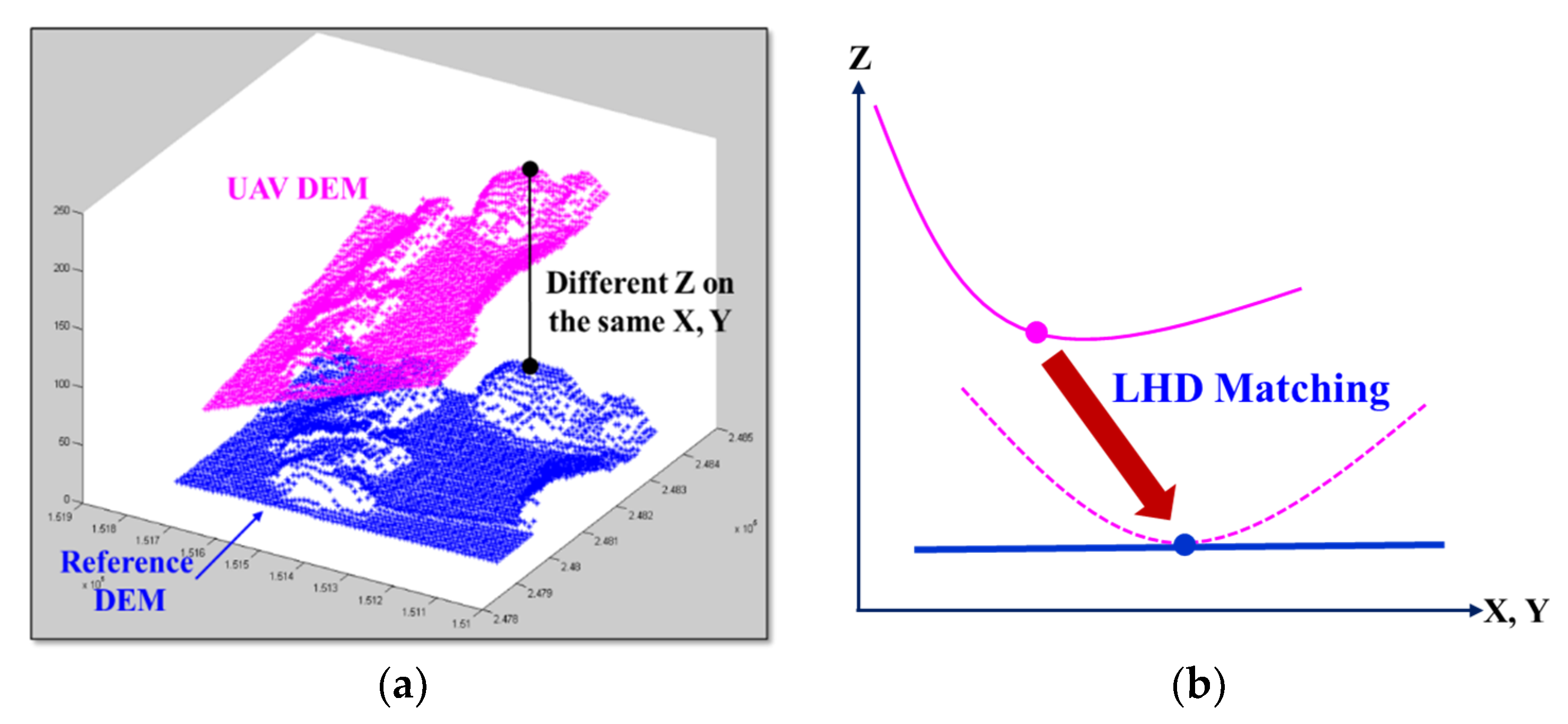

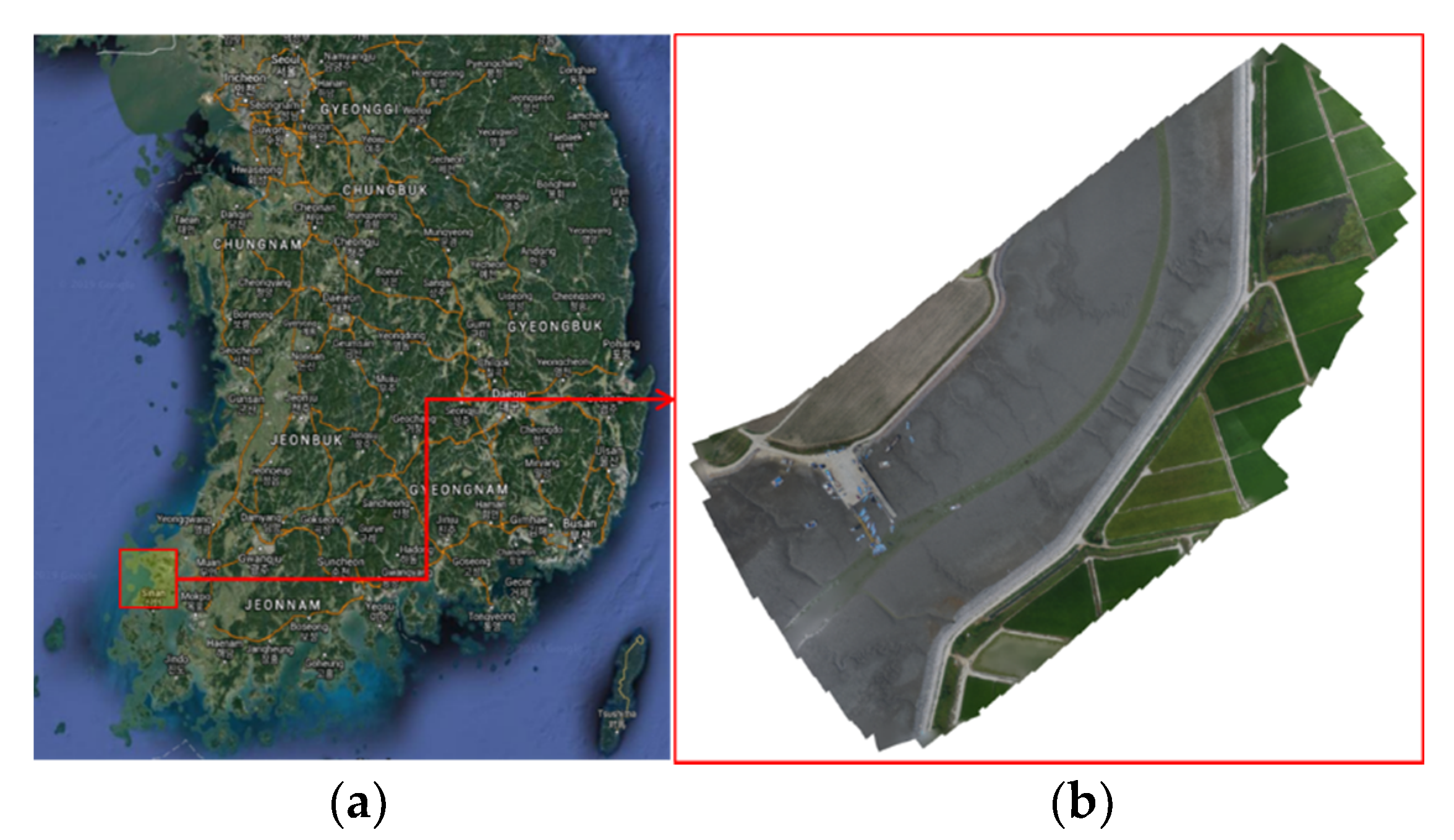

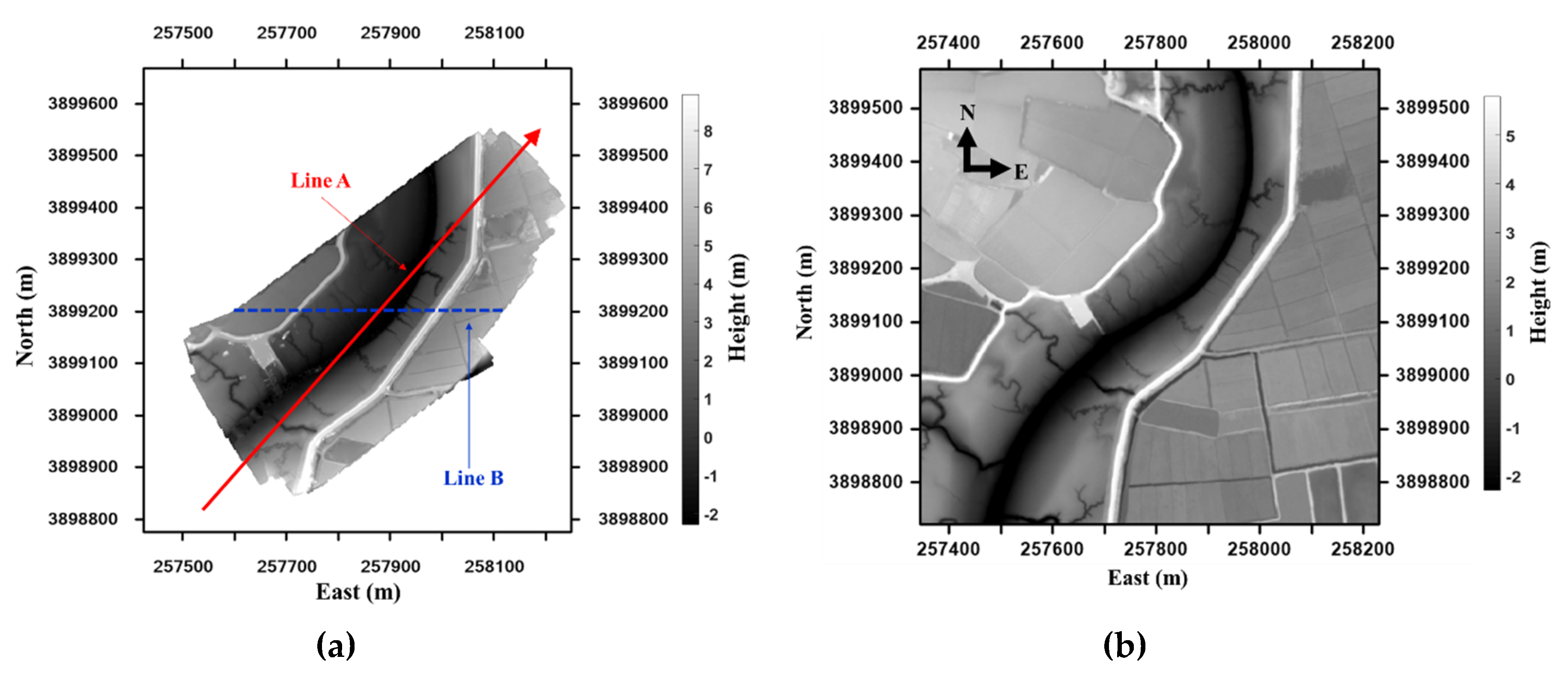
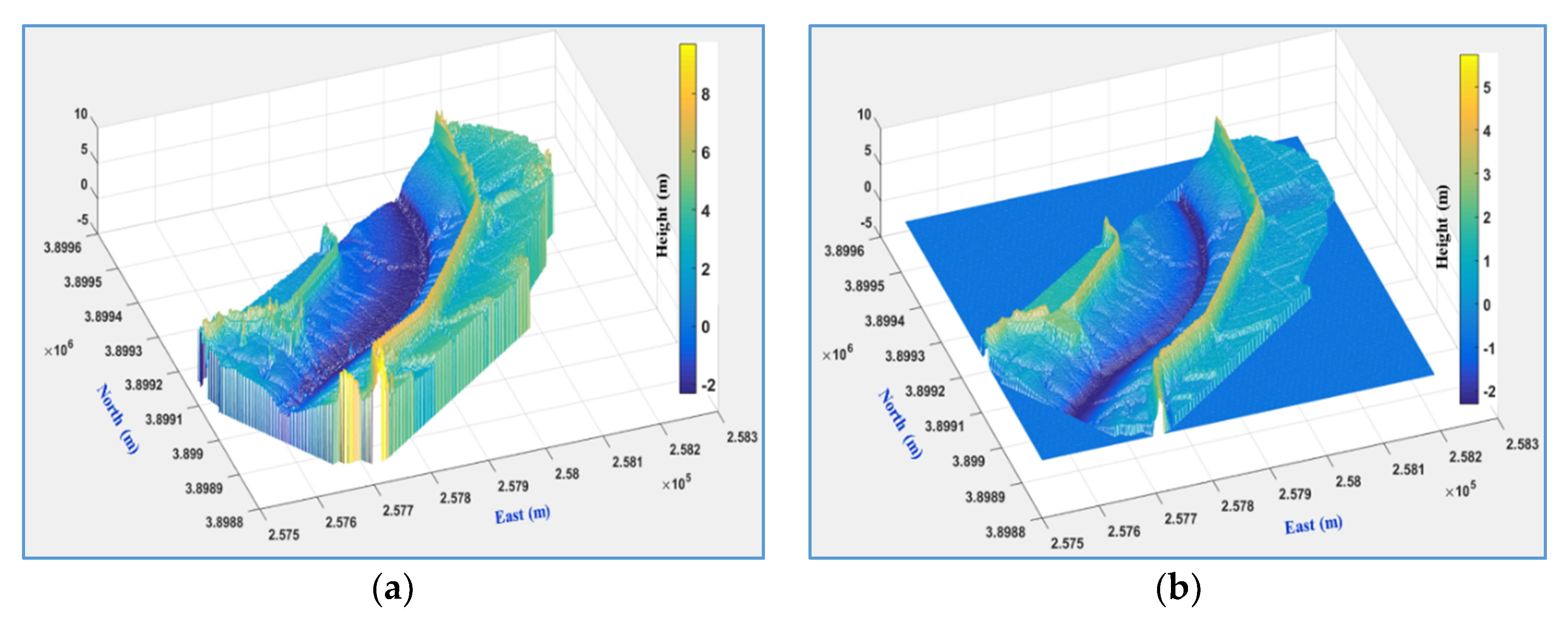
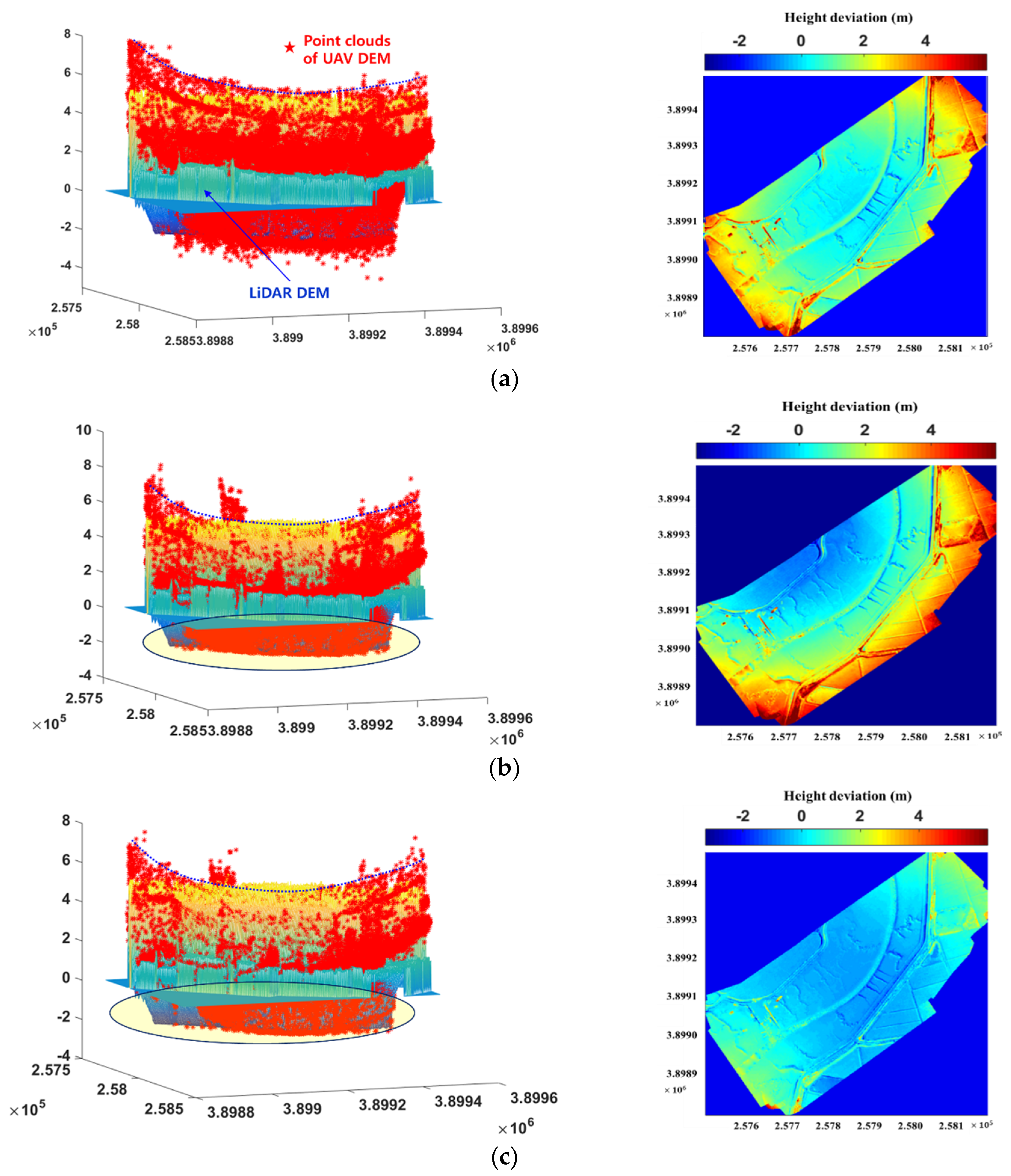


| Items | Parameters | |
|---|---|---|
| Phantom 4 | Weight | 1380 g |
| Max. speed | 20 m/s | |
| Flight time | 28 min | |
| GNSS | GPS, GLONASS | |
| Camera | Focal length | 3.61 mm |
| FOV | 94° | |
| Sensor size | 12.4 M (4000 × 3000) | |
| Case # | Parameters | |||||
|---|---|---|---|---|---|---|
| 1 | −0.59/0.012 | 0.33/0.013 | −0.03/0.004 | 0.34/0.002 | 0.32/0.002 | −0.02/0.003 |
| 2 | −0.18/0.070 | 0.66/0.074 | 10.85/0.131 | 1.19/0.008 | −0.51/0.008 | −0.02/0.015 |
| 3 | −0.59/0.012 | 0.33/0.013 | 11.27/0.004 | 0.34/0.002 | 0.32/0.001 | −0.02/0.003 |
| 4 | 0.42/0.057 | 1.78/0.061 | 8.88/0.074 | 1.34/0.011 | −0.64/0.012 | 0.01/0.008 |
| 5 | 1.86/0.085 | 0.19/0.080 | 2.97/0.225 | 0.81/0.018 | −0.18/0.017 | −0.21/0.060 |
| 6 | 2.22/0.087 | 0.25/0.080 | 2.94/0.227 | 0.84/0.019 | −0.15/0.017 | −0.46/0.060 |
| 7 | 1.95/0.098 | 0.41/0.085 | 3.65/0.233 | 1.21/0.021 | −0.05/0.019 | −0.29/0.061 |
| 8 | −2.27/0.115 | 2.67/0.120 | 8.87/0.076 | 1.35/0.042 | −0.64/0.046 | 0.03/0.012 |
| 9 | −0.86/0.130 | 1.16/0.127 | 2.93/0.226 | 0.81/0.044 | −0.17/0.043 | −0.20/0.060 |
| 10 | −0.48/0.233 | 1.63/0.198 | 15.76/0.600 | 1.85/0.083 | −1.18/0.072 | −0.19/0.241 |
| 11 | −1.07/0.237 | 1.86/0.198 | 17.79/0.610 | 2.32/0.083 | −1.18/0.071 | 0.05/0.243 |
| Correction | Before | After: Case # | ||||||||||
|---|---|---|---|---|---|---|---|---|---|---|---|---|
| 1 | 2 | 3 | 4 | 5 | 6 | 7 | 8 | 9 | 10 | 11 | ||
| RMSE (m) | 1.37 | 1.24 | 1.21 | 1.12 | 1.11 | 1.11 | 1.10 | 1.11 | 1.10 | 1.10 | 1.10 | 1.10 |
| Max (m) | 7.84 | 6.76 | 6.28 | 5.99 | 6.00 | 5.98 | 5.96 | 5.95 | 5.98 | 5.95 | 5.95 | 5.94 |
| Correction | Before | After: Case # | ||||||||||
|---|---|---|---|---|---|---|---|---|---|---|---|---|
| 1 | 2 | 3 | 4 | 5 | 6 | 7 | 8 | 9 | 10 | 11 | ||
| RMSE (m) | 0.956 | 0.517 | 0.475 | 0.150 | 0.149 | 0.153 | 0.156 | 0.166 | 0.152 | 0.157 | 0.149 | 0.163 |
| Max (m) | 2.258 | 2.218 | 2.060 | 1.468 | 1.440 | 1.385 | 1.393 | 1.426 | 1.457 | 1.403 | 1.414 | 1.451 |
© 2020 by the authors. Licensee MDPI, Basel, Switzerland. This article is an open access article distributed under the terms and conditions of the Creative Commons Attribution (CC BY) license (http://creativecommons.org/licenses/by/4.0/).
Share and Cite
Lee, H.; Han, D. Rectification of Bowl-Shape Deformation of Tidal Flat DEM derived from UAV Imaging. Sensors 2020, 20, 1602. https://doi.org/10.3390/s20061602
Lee H, Han D. Rectification of Bowl-Shape Deformation of Tidal Flat DEM derived from UAV Imaging. Sensors. 2020; 20(6):1602. https://doi.org/10.3390/s20061602
Chicago/Turabian StyleLee, Hyoseong, and Dongyeob Han. 2020. "Rectification of Bowl-Shape Deformation of Tidal Flat DEM derived from UAV Imaging" Sensors 20, no. 6: 1602. https://doi.org/10.3390/s20061602





